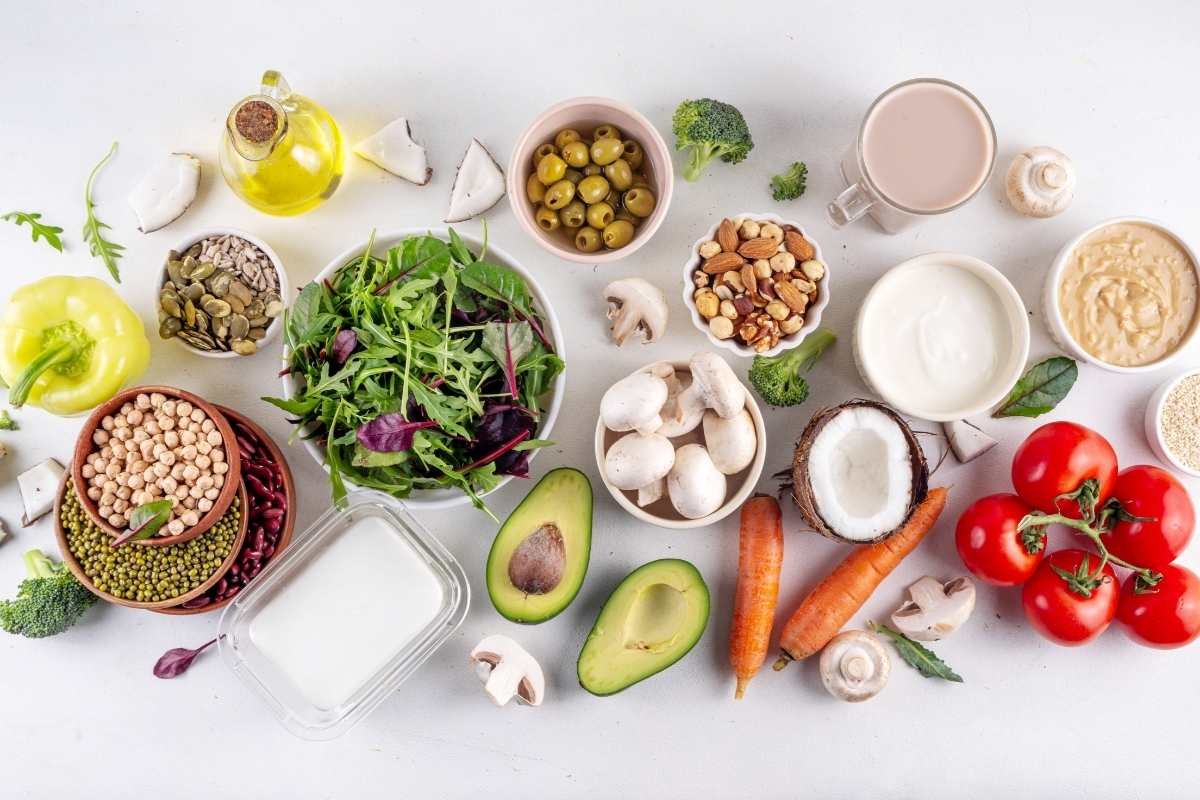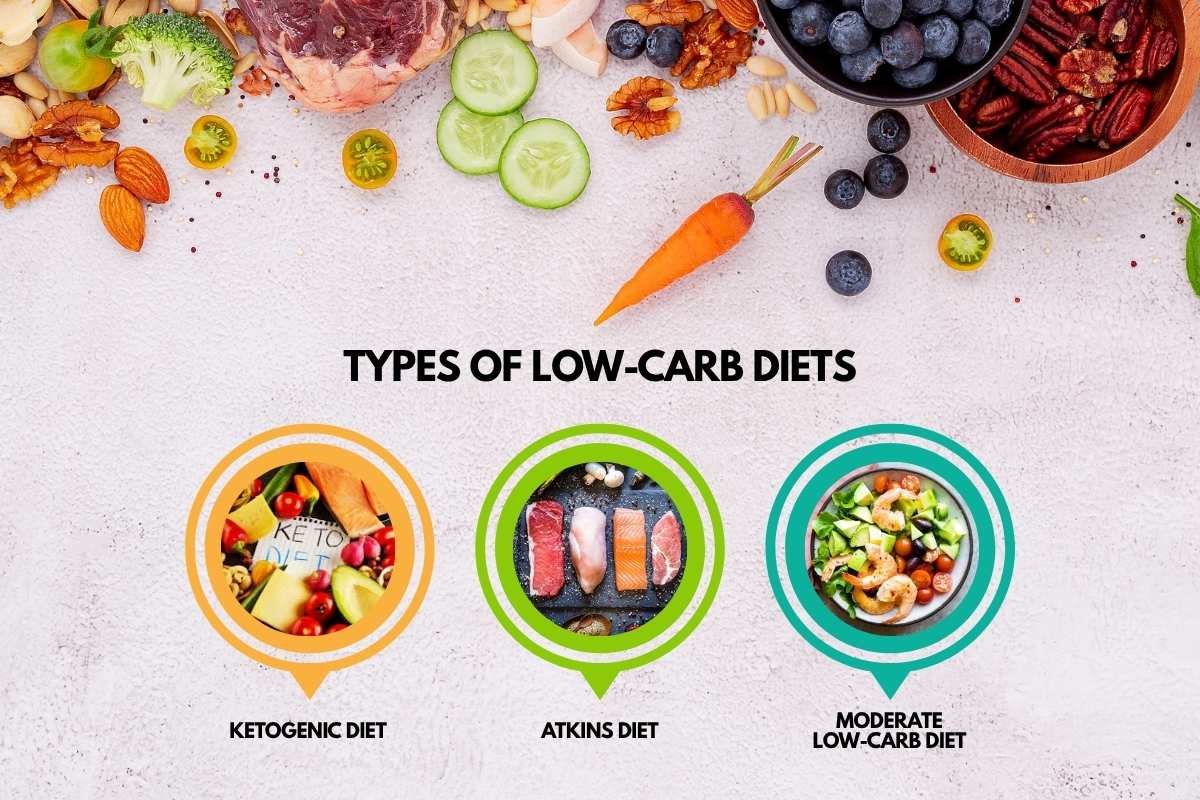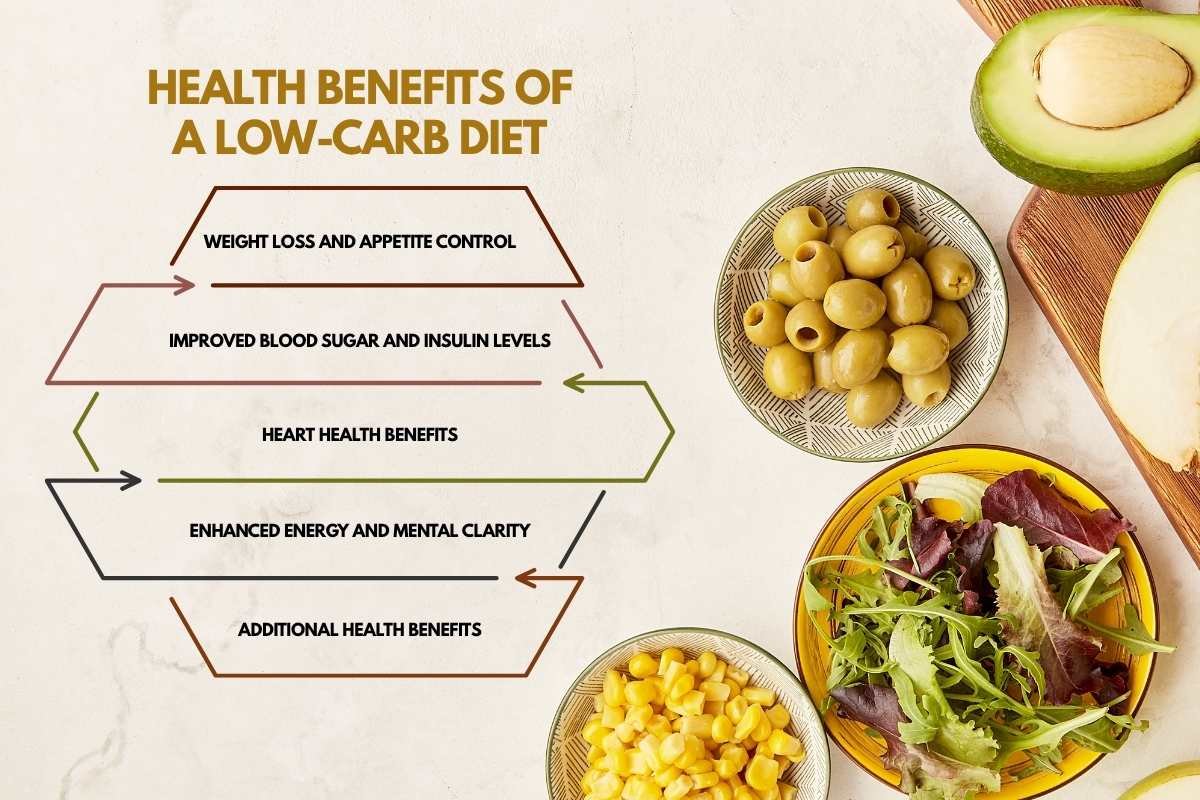copyright class="elementor-search-form" action="https://thelifesciencesmagazine.com/" method="get">
Burn Fat, Boost Energy, and Transform Your Health with This Low-Carb Diet Meal Plan
Follow a science-backed low-carb diet meal plan to lose weight, improve energy, and stabilize blood sugar. Includes a 7-day meal guide, grocery list, and expert tips for lasting results.

- Source: View more by rimmabondarenko
Are you looking to lose weight, improve energy, and support your overall health without counting every calorie or giving up satisfying meals? A low-carb diet meal plan could be the key. Research shows that reducing carbohydrate intake while focusing on protein, healthy fats, and non-starchy vegetables can help people lose 2–3 times more weight in the first six months compared to low-fat diets.
Low-carb diets are also linked to significant improvements in blood sugar and insulin levels. For instance, studies report a drop of 0.5–1% in HbA1c, a crucial marker for long-term blood sugar control, making this approach particularly beneficial for people with type 2 diabetes. Moreover, these diets can enhance heart health by raising HDL (“good”) cholesterol and reducing triglycerides by up to 20–30% in some individuals.
The best part? Low-carb eating isn’t about deprivation. By choosing lean proteins, healthy fats, and nutrient-rich vegetables, you can enjoy delicious meals, feel fuller for longer, and steadily burn fat. In this guide, we’ll explore everything you need: the science-backed health benefits, a 7-day low-carb meal plan, grocery essentials, mistakes to avoid, and expert tips so you can adopt a sustainable low-carb lifestyle and achieve real, measurable results.
What Is a Low-Carb Diet Meal Plan?
A low-carb diet meal plan is a structured approach to eating that focuses on reducing carbohydrate intake while emphasizing protein, healthy fats, and non-starchy vegetables. The main goal is to shift the body’s energy source from glucose—derived from carbs—to fat, a process that can enhance fat burning, stabilize blood sugar, and increase satiety.
1 How does it work?
When you reduce carbohydrate intake, your body uses up stored glycogen and begins burning fat for energy, producing molecules called ketones. This metabolic shift can lead to reduced appetite, greater fat loss, and more consistent energy levels. Studies indicate that people on low-carb diets often consume fewer calories naturally, with one review showing participants eating 200–500 fewer calories per day without actively restricting portions.
2. Types of Low-Carb Diets
Not all low-carb diets are the same. Here’s a breakdown of the most common approaches:

- Ketogenic Diet:
- Extremely low in carbs (typically 20–50 g/day or 5–10% of total calories)
- High in fats (70–75% of calories)
- Moderate protein (20–25%)
- Designed to induce ketosis, where fat becomes the primary energy source
- Atkins Diet:
- Starts with very low carbs (~20 g/day) and gradually increases
- Emphasizes protein and healthy fats
- Focuses on long-term weight management and metabolic flexibility
- Moderate Low-Carb Diet:
- Restricts carbs to around 100–130 g/day (20–30% of calories)
- Balances protein, fat, and nutrient-rich vegetables
- Suitable for those seeking sustainable weight loss without extreme restriction
By understanding these differences, you can choose a low-carb plan that aligns with your goals, lifestyle, and health needs.
Health Benefits of a Low-Carb Diet:
Low-carb diets are more than just a tool for weight loss—they offer multiple scientifically backed health benefits that can impact overall well-being. Research spanning decades highlights the effectiveness of low-carb eating for metabolic health, heart health, and long-term weight management.

1. Weight Loss and Appetite Control
One of the most well-documented benefits of a low-carb diet is its ability to promote weight loss. Studies show that individuals on low-carb diets can lose 2–3 times more weight in the first 6 months than those on low-fat diets. This happens partly because proteins and fats increase satiety, leading to fewer calories consumed naturally.
- Example: A 2018 meta-analysis of 23 studies found that participants following a low-carb diet lost an average of 8.5 lbs (3.85 kg) more in the first six months than those on low-fat diets.
- Additionally, reduced insulin levels help the body release stored fat, further supporting weight loss.
2. Improved Blood Sugar and Insulin Levels
For people with type 2 diabetes or prediabetes, controlling blood sugar is crucial. Low-carb diets have been shown to:
- Lower fasting blood glucose by 10–15 mg/dL in some studies.
- Reduce HbA1c levels by 0.5–1%, comparable to some diabetes medications.
- Decrease the need for insulin or other glucose-lowering medications in some individuals.
This makes low-carb eating a practical strategy for stabilizing blood sugar levels and reducing the risk of long-term complications.
Also Read:
- Foods to Avoid in Diabetes to Stay Strong and Control Sugar Levels
- Crafting Effective Diabetes Meal Plans for Weight Loss: A Comprehensive Guide
3. Heart Health Benefits
Low-carb diets can positively affect several cardiovascular risk factors:
- HDL (good) cholesterol tends to increase by 5–10%, supporting heart health.
- Triglycerides, which are strongly linked to heart disease, often decrease by 20–30%.
- Some studies report improvements in LDL particle size, which is considered a better predictor of cardiovascular risk than total LDL levels.
Overall, a low-carb diet may help improve lipid profiles and reduce heart disease risk, especially when combined with whole, nutrient-rich foods.
4. Enhanced Energy and Mental Clarity
Many individuals report more consistent energy levels and reduced mental fatigue when switching to a low-carb diet. This is because fat and ketones provide a steady source of fuel, avoiding the energy spikes and crashes associated with high-carb meals.
Anecdotal evidence and small clinical studies suggest improved focus, concentration, and cognitive performance for some people on low-carb diets, particularly during the adaptation phase.
5. Additional Health Benefits
- Blood pressure reduction: Some participants see decreases of 5–10 mmHg in systolic blood pressure.
- Reduced inflammation: Markers like C-reactive protein (CRP) may decline, lowering chronic disease risk.
- Metabolic syndrome support: Low-carb diets can improve multiple metabolic syndrome components simultaneously, including waist circumference, triglycerides, and fasting glucose.
By targeting multiple aspects of health, from weight management to heart and metabolic health, a low-carb diet meal plan offers a comprehensive approach to wellness.
Sample Low-Carb Diet Meal Plans:
Following a structured low-carb diet meal plan is essential for achieving results while keeping meals satisfying. Below is a 7-day sample plan designed for approximately 100–130 grams of carbs per day, which is suitable for most individuals seeking weight loss, metabolic improvements, and sustainable energy levels.
Day 1
| Breakfast | Scrambled eggs with spinach and feta cheese | 5 g carbs |
| Snack | 10 almonds | 2 g carbs |
| Lunch | Grilled chicken salad with mixed greens, cherry tomatoes, cucumber, and olive oil dressing | 10 g carbs |
| Snack | Celery sticks with 2 tbsp of peanut butter | 5 g carbs |
| Dinner | Baked salmon with steamed broccoli and avocado | 12 g carbs |
| Total carbs | 34 g | |
Day 2
| Breakfast | Greek yogurt with chia seeds and a few blueberries | 10 g carbs |
| Snack | Cheese slices | 1 g carbs |
| Lunch | Beef stir-fry with bell peppers and zucchini | 12 g carbs |
| Snack | Hard-boiled egg | 1 g carbs |
| Dinner | Roasted chicken thighs with cauliflower mash and green beans | 15 g carbs |
| Total carbs | 39 g | |
Day 3
| Breakfast | Omelet with mushrooms, onions, and cheddar cheese | 6 g carbs |
| Snack | Walnuts (10 halves) | 2 g carbs |
| Lunch | Tuna salad lettuce wraps | 8 g carbs |
| Snack | Greek yogurt with cinnamon | 5 g carbs |
| Dinner | Grilled shrimp sautéed in butter with asparagus | 10 g carbs |
| Total carbs | 31 g | |
Day 4
| Breakfast | Avocado smoothie with spinach, almond milk, and protein powder | 12 g carbs |
| Snack | String cheese | 1 g carbs |
| Lunch | Turkey and cheese roll-ups with leafy greens | 5 g carbs |
| Snack | Cucumber slices with guacamole | 4 g carbs |
| Dinner | Pork chops with sautéed zucchini and mushrooms | 10 g carbs |
| Total carbs | 32 g | |
Day 5
| Breakfast | Scrambled eggs with smoked salmon and avocado | 5 g |
| Snack | 10 macadamia nuts | 2 g carbs |
| Lunch | Grilled chicken Caesar salad | 10 g carbs |
| Snack | Celery with cream cheese | 3 g carbs |
| Dinner | Eggplant lasagna with ground turkey and mozzarella | 15 g carbs |
| Total carbs | 35 g | |
Day 6
| Breakfast | Veggie frittata | 6 g carbs |
| Snack | Half an avocado with lime and salt | 3 g carbs |
| Lunch | Beef taco bowls with cauliflower rice and salsa | 12 g carbs |
| Snack | Hard-boiled eggs | 1 g carbs |
| Dinner | Lemon-butter salmon with roasted Brussels sprouts | 10 g carbs |
| Total carbs | 32 g | |
Day 7
| Breakfast | Chia pudding with unsweetened almond milk and raspberries | 10 g carbs |
| Snack | 10 pecans | 2 g carbs |
| Lunch | Cobb salad with grilled chicken, egg, bacon, avocado, and blue cheese | 12 g carbs |
| Snack | Cheese slices | 1 g carbs |
| Dinner | Garlic butter shrimp with zucchini noodles | 8 g carbs |
| Total carbs | 33 g | |
Tips for Following This Meal Plan
- Portion Control: Adjust serving sizes based on your weight goals and activity levels.
- Swap Ingredients: You can replace proteins or vegetables with low-carb alternatives you enjoy.
- Hydration: Drink at least 2–3 liters of water daily, especially during the first week.
- Track Carbs: Keep a food journal to ensure you stay within your target carb range.
Also Read:
- 5 Things That Happen to Your Body When You Skip Meals
- 5 Reasons Why Experts Recommend a High-Protein Diet
Grocery List for a Low-Carb Diet
Stocking your kitchen with the right foods is essential for following a low-carb diet meal plan successfully. A well-planned grocery list ensures you have nutritious, low-carb options on hand, making it easier to stick to your goals. Based on research and popular low-carb strategies, here’s a tabular representation list:
| Category | Food Items | Net Carbs (Approx.) | Key Benefits |
| Proteins | Chicken breast/thighs | 0 g per 100 g | High protein supports muscle maintenance |
| Beef, pork, lamb | 0–1 g per 100 g | Rich in iron, B vitamins | |
| Salmon, mackerel, tuna | 0–1 g per 100 g | High in omega-3 fatty acids, heart health | |
| Eggs | 0.6 g per large egg | Complete protein, essential nutrients | |
| Vegetables | Spinach, kale, arugula | 1–2 g per cup | High in fiber, vitamins, minerals |
| Broccoli, cauliflower, Brussels sprouts | 3–5 g per cup | Non-starchy, supports digestion | |
| Zucchini, bell peppers, asparagus, mushrooms, and cucumber | 2–4 g per cup | Low-calorie, nutrient-dense | |
| Fruits (Low-Carb) | Strawberries, blueberries, raspberries | 5–12 g per 100 g | Rich in antioxidants, low sugar |
| Blackberries | 5 g per 100 g | High fiber, low carb | |
| Dairy | Cheese (cheddar, mozzarella, feta) | 1–2 g per 30 g | Protein, calcium, healthy fats |
| Greek yogurt (unsweetened) | 4 g per 100 g | High protein, low sugar | |
| Heavy cream | 0.4 g per tbsp | Useful in cooking or coffee, low carb | |
| Healthy Fats & Oils | Avocado | 2 g per 100 g | Monounsaturated fats, potassium |
| Olive oil, avocado oil, coconut oil | 0 g | Supports satiety, fat-soluble vitamin absorption | |
| Nuts (almonds, walnuts, macadamia) | 2–5 g per 28 g | Healthy fats, protein, fiber | |
| Seeds (chia, flax, pumpkin) | 1–4 g per tbsp | High in fiber, omega-3s | |
| Beverages | Water | 0 g | Hydration, essential for metabolism |
| Herbal teas (unsweetened) | 0 g | Zero-calorie, antioxidants | |
| Black coffee | 0 g | Boosts energy and focus |
Common Mistakes to Avoid on a Low-Carb Diet

1. Overeating Protein
While protein is essential for muscle maintenance and satiety, consuming too much can be counterproductive. Excess protein can be converted into glucose through a process called gluconeogenesis, which may reduce fat-burning efficiency. Aim for moderate protein intake, around 1.2–1.6 grams per kilogram of body weight per day.
2. Neglecting Vegetables
Many people focus on protein and fats but forget non-starchy vegetables. Skipping vegetables reduces fiber, vitamins, and minerals, which can lead to digestive issues like constipation. Make sure to include 3–5 cups of low-carb vegetables daily to support gut health and overall nutrition.
3. Hidden Carbs
Processed foods, sauces, and dressings often contain hidden sugars, which can unintentionally push your daily carb intake above target. Always read labels carefully and opt for homemade or low-carb alternatives whenever possible.
4. Not Drinking Enough Water
Low-carb diets can increase water and electrolyte loss, leading to fatigue, headaches, or the so-called “keto flu.” To stay healthy, drink 2–3 liters of water daily and consider replenishing electrolytes like sodium, potassium, and magnesium.
5. Unrealistic Expectations
Expecting rapid weight loss can lead to disappointment. Sustainable fat loss usually occurs at 1–2 pounds per week, which helps prevent muscle loss and keeps metabolism stable.
6. Skipping Meals or Undereating
Some people drastically reduce calories, thinking it will speed up results. Extreme calorie restriction can slow metabolism, reduce energy, and make it harder to maintain muscle. Stick to a balanced meal plan with healthy fats, protein, and vegetables, and eat regularly.
7. Ignoring Individual Needs
Everyone’s body and lifestyle are different. Not adjusting for activity level, age, or health conditions can limit effectiveness or cause deficiencies. Personalize your low-carb plan based on your goals, lifestyle, and any medical considerations.
Research shows that individuals who plan meals, track carb intake, stay hydrated, and include enough vegetables are far more likely to succeed long-term on a low-carb diet. Being aware of these common mistakes allows you to avoid them, making the diet more effective and sustainable.
How to Personalize Your Low-Carb Diet Meal Plan?
While the basic principles of a low-carb diet meal plan are the same for everyone—reducing carbs, increasing protein and healthy fats, and eating plenty of non-starchy vegetables personalization is key to long-term success. Everyone’s metabolism, activity level, health goals, and taste preferences are different. Here’s how to tailor a low-carb diet to your needs:
1. Consider Your Activity Level
Active individuals, especially those who exercise intensely or do strength training, may require slightly higher carb intake around workouts for energy. For example, athletes may benefit from 20–30 g of extra carbs pre- or post-workout from low-glycemic vegetables or berries. Sedentary individuals can maintain a lower carb intake to maximize fat burning.
2. Adjust Based on Health Conditions
- Diabetes or Prediabetes: A lower-carb approach (50–100 g/day) can help stabilize blood sugar. Monitor glucose levels and consult a healthcare provider before major changes.
- Kidney Concerns: Moderate protein intake is important; extremely high-protein diets may strain kidney function.
- Heart Health: Include plenty of healthy fats like olive oil, avocado, and fatty fish while limiting processed meats.
Also Read: Cooking Oil: Types & How to Choose the Right Oil
3. Tailor to Food Preferences
The most sustainable diet is one you enjoy. Swap proteins, vegetables, and fats for alternatives you like. For example:
- If you dislike broccoli, try zucchini or asparagus.
- If you’re vegetarian, incorporate tofu, tempeh, nuts, and seeds as protein sources.
4. Adjust Portion Sizes for Goals
- Weight Loss: Slight calorie deficit (200–500 kcal/day) combined with low carbs promotes fat loss.
- Maintenance: Balance calories with energy expenditure to maintain weight.
- Muscle Gain: Ensure adequate protein and slightly higher calories with moderate carb intake around workouts.
5. Monitor and Track Progress
Track your weight, body measurements, energy levels, and blood markers (like glucose or cholesterol) to see how your body responds. Adjust your carb intake, fat sources, and protein based on results.
6. Experiment Gradually
Introduce changes slowly. If switching from a high-carb diet, reduce carbs step by step to avoid fatigue, headaches, or digestive issues. Gradual adaptation allows your body to burn fat efficiently while minimizing side effects.
Personalization is critical for adherence and long-term success. Research indicates that individuals who adjust their carb intake, protein, and fat based on activity, health, and preferences are more likely to sustain a low-carb lifestyle and achieve measurable health improvements.
Expert Tips for Long-Term Success on a Low-Carb Diet
Adopting a low-carb diet meal plan is just the first step; staying consistent and making it sustainable is key to achieving long-term results. Nutrition experts and research studies highlight several strategies that increase adherence and improve outcomes:
1. Focus on Whole, Unprocessed Foods
Eating whole foods like lean proteins, non-starchy vegetables, nuts, seeds, and healthy fats ensures you get nutrient-dense meals without hidden sugars or refined carbs. Processed low-carb “snacks” or packaged foods often contain additives and can stall progress. Studies show diets rich in whole foods lead to better satiety, improved cholesterol profiles, and more sustainable weight loss.
2. Plan Meals in Advance
Meal planning prevents last-minute high-carb choices and keeps your diet on track. Prepare meals for the week, keep low-carb snacks handy, and batch-cook proteins and vegetables. Experts recommend prepping 2–3 meals at a time, which can reduce stress and improve adherence.
3. Track Carbs and Macros
Use apps or a food journal to monitor your daily intake of carbs, protein, and fats. Even occasional tracking can help you stay within your target range and identify hidden carbs. Research shows that tracking intake improves compliance and results in greater weight loss compared to non-tracking approaches.
4. Incorporate Variety
Eating a variety of proteins, vegetables, and healthy fats prevents nutrient deficiencies and keeps meals interesting. Rotate different meats, fish, and plant-based proteins, and include a range of vegetables and low-carb fruits. Variety also supports gut health, as diverse fiber sources feed beneficial gut bacteria.
5. Stay Hydrated and Maintain Electrolytes
Low-carb diets can increase water and sodium loss. Proper hydration, along with adequate potassium and magnesium, helps prevent fatigue, headaches, and muscle cramps. Aim for 2–3 liters of water per day and include electrolyte-rich foods like leafy greens, nuts, and avocados.
6. Practice Mindful Eating
Even on a low-carb diet, portion sizes matter. Eat slowly, recognize hunger cues, and stop when satisfied. Mindful eating reduces overeating and helps maintain long-term success.
7. Allow Flexibility
Occasional social events or cravings are normal. Planning small indulgences or higher-carb meals occasionally (sometimes called “carb cycling”) can improve adherence without sabotaging progress.
8. Regular Monitoring
Track your weight, body measurements, energy levels, and health markers like blood sugar, cholesterol, or blood pressure. Adjust your carb intake, fat sources, and protein accordingly to optimize results.
Experts agree that combining meal planning, variety, hydration, mindful eating, and tracking is essential for sustainable success. Research demonstrates that people who implement these strategies consistently experience better weight management, metabolic improvements, and long-term health benefits.
Also Read:
Conclusion
A low-carb diet meal plan is a proven, science-backed way to lose weight, stabilize blood sugar, and boost overall health. By focusing on protein, healthy fats, and non-starchy vegetables, you can feel full, energized, and in control of your health.
Success comes from planning, personalization, and consistency—using structured meals, stocking nutrient-dense foods, avoiding common mistakes, and monitoring progress. With the right approach, a low-carb diet isn’t just a short-term plan; it’s a sustainable path to lasting wellness.
FAQs About Low-Carb Diet Meal Plans
Here are some of the most commonly asked questions about low-carb diet meal plans, along with evidence-based answers to help you make informed choices.
1. How many carbs should I eat on a low-carb diet?
Most low-carb diets recommend 50–130 grams of net carbs per day. For those following a ketogenic approach, carbs are usually limited to 20–50 grams per day to maintain ketosis. The exact number depends on your goals, activity level, and health conditions.
2. Can I eat fruit on a low-carb diet?
Yes, but focus on low-carb fruits like berries (strawberries, blueberries, raspberries, and blackberries). They provide fiber, antioxidants, and vitamins while keeping carb intake low. Limit fruit servings to 1–2 per day to stay within your carb target.
3. Is it safe to eat fat on a low-carb diet?
Absolutely. Healthy fats like avocado, olive oil, fatty fish, nuts, and seeds are essential for energy, satiety, and absorption of fat-soluble vitamins (A, D, E, K). Research shows diets higher in healthy fats can improve HDL cholesterol and reduce triglycerides.
4. Will I lose muscle on a low-carb diet?
If protein intake is adequate and combined with regular strength training, muscle loss can be minimized. Aim for 1.2–1.6 g of protein per kilogram of body weight per day, and include resistance exercises to preserve lean mass.
5. Can I exercise on a low-carb diet?
Yes. While high-intensity performance may initially feel reduced due to lower glycogen, most people adapt over 2–4 weeks. Fat-adapted energy systems improve endurance, and incorporating moderate carbs around workouts can help maintain performance.
